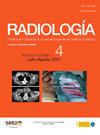Protocolo rápido de resonancia magnética cardiaca. Viabilidad de las secuencias cine aceleradas con compressed sensing en la práctica clínica
IF 1.1
Q3 RADIOLOGY, NUCLEAR MEDICINE & MEDICAL IMAGING
引用次数: 0
Abstract
Objective
To demonstrate the feasibility of cardiac magnetic resonance (CMR) cine sequences with compressed-sensing (CS) acceleration in the assessment of ventricular anatomy, volume, and function; and to present a fast CRM protocol that improves scan efficiency.
Methods
Prospective study of consecutive patients with indication for CMR who underwent CS short-axis (SA) cine imaging compared with conventional SA cine imaging. We analysed ejection fraction (EF), end-diastolic volume (EDV), stroke volume (SV), and myocardial thickness. Two blinded independent observers performed the reading. Inter- and intraobserver agreement was calculated for all the measurements. Image quality of conventional and CS cine sequences was also assessed.
Results
A total of 50 patients were included, 22 women (44%) with a mean age of 57.3 ± 13.2 years. Mean left ventricular EF was 59.1% ± 10.4% with the reference steady-state free precession sequences, versus 58.7% ± 10.6% with CS; and right ventricular EF with conventional imaging was 59.3% ± 5.7%, versus 59.5% ± 6.1% with CS. Mean left ventricular EDV for conventional sequences and CS were 166.8 and 165.1 ml respectively; left ventricular SV was 94.5 versus 92.6 ml; right ventricular EDV was 159.3 versus 156.4 ml; and right ventricular SV was 93.6 versus 91.2 ml, respectively. Excellent intra and interobserver correlations were obtained for all parameters (Intraclass correlation coefficient between 0.932 and 0.99; CI: 95%). There were also no significant differences in ventricular thickness (12.9 ± 2.9 mm vs. 12.7 ± 3.1 mm) (p< .001). The mean time of CS SA was < 40 sec versus 6-8 min for the conventional SA. The mean duration of the complete study was 15 ± 3 min.
Conclusions
Cine CS sequences are feasible for assessing biventricular function, volume, and anatomy, enabling fast CMR protocols.
快速心脏磁共振成像方案。在临床实践中使用压缩传感加速电影序列的可行性。
目的探讨压缩感应(CS)加速心脏磁共振(CMR)序列在心室解剖、体积和功能评估中的可行性;并提出了一个快速的CRM协议,提高了扫描效率。方法前瞻性研究连续有CMR指征的患者行CS短轴(SA)影像与常规SA影像比较。我们分析了射血分数(EF)、舒张末期容积(EDV)、卒中容积(SV)和心肌厚度。两位盲法独立观察者进行了阅读。计算了所有测量结果的观察者之间和观察者内部的一致性。并对常规和CS序列的图像质量进行了评价。结果共纳入50例患者,其中女性22例(44%),平均年龄57.3±13.2岁。参考稳态自由进动序列左室EF均值为59.1%±10.4%,CS组为58.7%±10.6%;常规影像右室EF为59.3%±5.7%,CS为59.5%±6.1%。常规序列和CS的平均左室EDV分别为166.8和165.1 ml;左室SV为94.5 vs 92.6 ml;右心室EDV分别为159.3 ml和156.4 ml;右心室SV分别为93.6 ml和91.2 ml。所有参数在观察者内和观察者间均具有良好的相关性(类内相关系数为0.932 ~ 0.99;置信区间:95%)。两组心室厚度也无显著差异(12.9±2.9 mm vs 12.7±3.1 mm) (p<;措施)。cssa的平均时间为<;40秒,而传统SA为6-8分钟。完整研究的平均持续时间为15±3分钟。结论科学CS序列可用于评估双心室功能,体积和解剖结构,实现快速CMR方案。
本文章由计算机程序翻译,如有差异,请以英文原文为准。
求助全文
约1分钟内获得全文
求助全文
来源期刊

RADIOLOGIA
RADIOLOGY, NUCLEAR MEDICINE & MEDICAL IMAGING-
CiteScore
1.60
自引率
7.70%
发文量
105
审稿时长
52 days
期刊介绍:
La mejor revista para conocer de primera mano los originales más relevantes en la especialidad y las revisiones, casos y notas clínicas de mayor interés profesional. Además es la Publicación Oficial de la Sociedad Española de Radiología Médica.
 求助内容:
求助内容: 应助结果提醒方式:
应助结果提醒方式:


